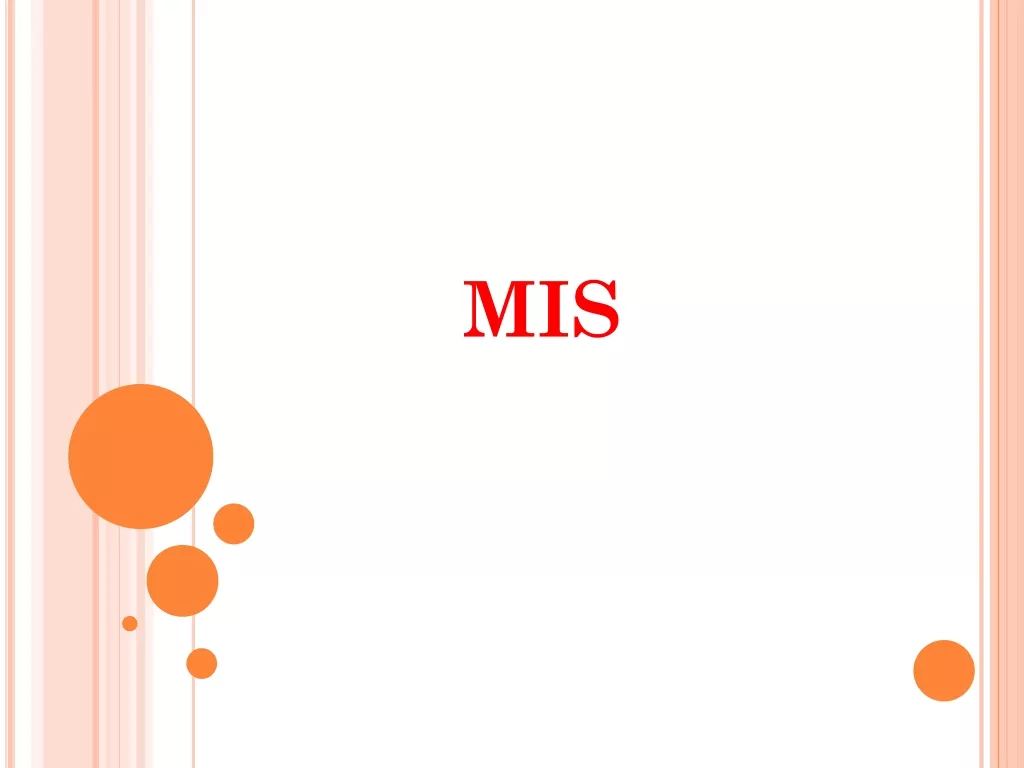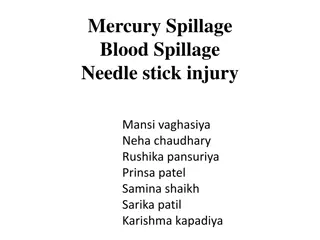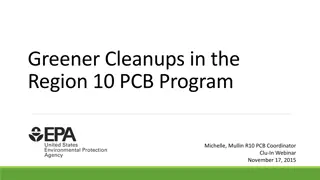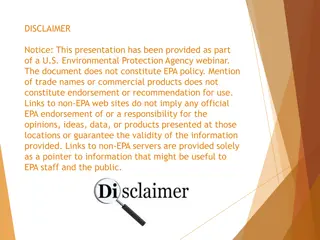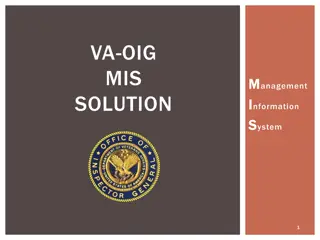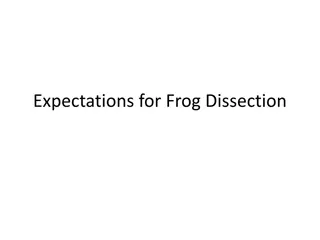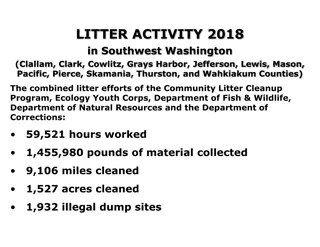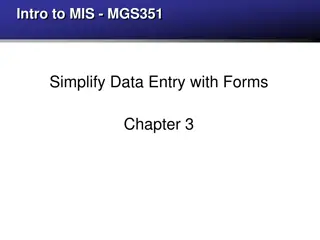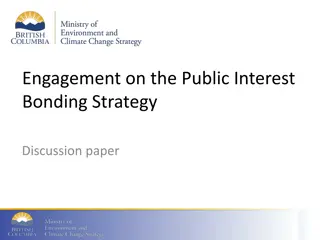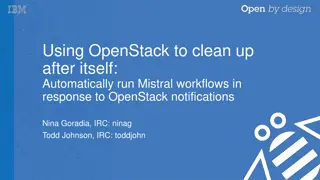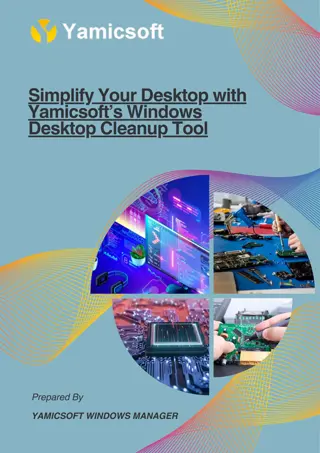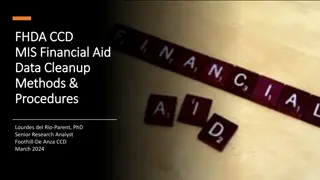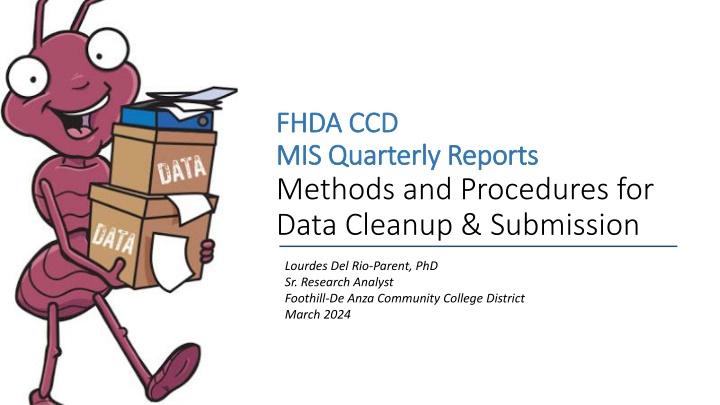
Data Cleanup Process for MIS Quarterly Reports at FHDA-CCD
Explore the methods and procedures for data cleanup and submission of MIS quarterly reports at FHDA-CCD, including identifying errors, summarizing the cleanup process, utilizing technology, and discussing data quality standards adoption.
Download Presentation

Please find below an Image/Link to download the presentation.
The content on the website is provided AS IS for your information and personal use only. It may not be sold, licensed, or shared on other websites without obtaining consent from the author. If you encounter any issues during the download, it is possible that the publisher has removed the file from their server.
You are allowed to download the files provided on this website for personal or commercial use, subject to the condition that they are used lawfully. All files are the property of their respective owners.
The content on the website is provided AS IS for your information and personal use only. It may not be sold, licensed, or shared on other websites without obtaining consent from the author.
E N D
Presentation Transcript
FHDA CCD FHDA CCD MIS Quarterly Reports MIS Quarterly Reports Methods and Procedures for Data Cleanup & Submission Lourdes Del Rio-Parent, PhD Sr. Research Analyst Foothill-De Anza Community College District March 2024
Goals and Objectives Goals and Objectives Provide an overview of the MIS quarterly reports Identify reports or data files submitted during the MIS quarterly submission Illustrate relationships/dependencies between reports Identify data check types or errors: syntactical, referential, quality Summarize the data cleanup process used for the MIS quarterly reports at FHDA, including key steps prior and after the original submission Identify some of the external data sources used for the data cleanup and submission Show the use of technology for data cleanup and submission Illustrate key steps Identify resources data custodians can use to review the data prior resubmission at the end of the academic year Identify limitations of the data cleanup process Discuss the need to adopt data quality standards across the District
The MIS Quarterly Reports The MIS Quarterly Reports CB Courses SB Student Characteristics XB Sections SY Prior Learning CW CalWORKs SE EOPS XF Meets SD DSPS SG Spec Populations XE Faculty Assignment EB Faculty Demographics SS 3SP SV VTEA SX Enrollment
MIS Submission Errors MIS Submission Errors 1. Syntactical errors signal problems with data values within the report or data file. Scope: report (i.e., invalid values or discrepancies in the report) Data values do not meet specs, as documented in the MIS DED (data element dictionary) Example 1: The report shows that the credit status for a course is M (invalid value). Example 2: A course is classified as credit-degree applicable and basic skills (discrepancies between data fields submitted for the course). Referential errors indicate a broken relationship between data files (parent-child). Scope: Between reports or data files, including the MIS master lists for courses or programs Example 1: The student ID in the SE (EOPS) report does not appear in the SB (Student Characteristics) report. Example 2: The TOP code submitted for the course (CB00 control number) is not the same TOP code in the master list for that course. Quality errors relate to the data not meeting expected parameters. Scope: Varies Example: The percentage of records with RD (report delayed) as official grade > 2.5. 2. 3.
The Cascading Effect of Submission Errors The Cascading Effect of Submission Errors CB Courses XB Sections XF Meets EB Faculty Demographics XE Faculty Assignment SX Student Enrollment
MIS Quarterly MIS QuarterlyReports: Key Steps Reports: Key Steps Data cleanup- Banner data (SQL Developer, Argos, Excel) Data submission (SAS, Toad) Analyze data and publish results in FHDA IRP MIS website (SQL, Excel) Preliminary data extracts/reports (SQL Developer, SAS, Excel) Test data and send final reminder to data custodians with copy to managers Submit data Upload/save data files in the ODS for future reference Update tables, scripts, views for reporting term Schedule data cleanup reports (e.g., Argos reports emailed weekly to data custodians) Test and confirm data for categorical programs and special populations Clockworks Degree Works SARS CCC Data Warehouse CVC-OEI National Student Clearinghouse Basic Need Centers Canvas CCC Curriculum Inventory Resubmission at the end of the year Document pending data validity issues Compare figures between corresponding terms
Data Cleanup for MIS CB Data Cleanup for MIS CB- -Courses Courses Run the CB-Argos report to identify discrepancies between the CCC course inventory and Banner data; email error report to curriculum coordinators at the colleges Prior submission date, test the CB report using the CCCCO MIS server to identify any new data checks (syntactical or referential checks) Download and process COCI and MIS CB master data; update local copy of CCC course inventory Update SQL MIS views and Argos report for the academic year Resubmit data at the end of the year
MIS CB MIS CB- -Courses, Argos Report Courses, Argos Report The CB-Argos report is used to identify discrepancies between the CCC curriculum inventory (COCI) and Banner-production data for courses with enrollment during the academic year. The CB-Argos report includes an email message and a CSV file. The message explains the purpose of the report and provides instructions on how to address found discrepancies. The CSV file identifies the course, the issue/discrepancy, and related course data in COCI and Banner.
MIS CB Argos, MIS CB Argos, email message email message
MIS CB Argos, MIS CB Argos, CSV attachment CSV attachment
Data Cleanup, Categorical Programs Data Cleanup, Categorical Programs At FHDA, data custodians for categorical programs (CalWORKs, DSPS, EOPS/CARE) and some special population groups (A2MEND, Bachelors Degree, Basic Need Center, CAFYES/NextUp, CCAP, College Now, Dual Admissions, Incarcerated, Juvenile-Justice Impacted, MESA, Middle College, Puente, Umoja) need to review and confirm the list of students served by the program during the reporting term before submission date. Otherwise, data for the program is not included in the submission. At least three weeks prior to submission date, Argos reports are emailed at least once a week to all data custodians for categorical and special population programs. Prior to submission date, data custodians need to resolve all issues identified in the Argos report and then send an email to the MIS coordinator confirming the headcount for the group.
SE SE- -EOPS Data Cleanup EOPS Data Cleanup Once the report shows no error and all and only students served are included, the data custodian confirms the list/headcount; the MIS coordinator checks and stops the Argos report once all issues are resolved Data custodian makes modifications to the Banner- production system to address/resolve data issues in the report EOPS Argos runs at least once a week for at least three weeks prior submission Update SQL MIS views and schedule Argos reports
MIS SE MIS SE- -EOPS Argos Email Message EOPS Argos Email Message
SE SE- -EOPS Argos, EOPS Argos, email attachment email attachment
FHDA Argos Reports used for MIS Quarterly FHDA Argos Reports used for MIS Quarterly A list of Argos reports used for the MIS data cleanup at FHDA is available at the FHDA IRP MIS Reports webpage. 1. Go to: http://research.fhda.edu/mis_reports/ 2. Under the Introductionsection, click on Argos Reports Used at FHDA for the MIS Quarterly Data Cleanup to download an Excel file with the list. These reports are used to cleanup data in Banner-Production, which also helps in the validation/data cleanup for other reports (e.g., apportionment 320, 321).
Resources to Review Submitted Data Prior Resubmission Resources to Review Submitted Data Prior Resubmission at the End of Academic Year at the End of Academic Year California Community Colleges Chancellor s Office MIS Data Mart (https://datamart.cccco.edu/Default.aspx) MIS Quarterly Submission Reports (http://research.fhda.edu/mis_reports/mis_quarterly_submssion_rep ort/)
FHDA IRP MIS Quarterly Submission Reports FHDA IRP MIS Quarterly Submission Reports The quarterly submission reports are designed to (a) provide a quick summary of issues that may threaten the validity of the data submitted to the California Community Colleges Chancellor s Office by the District, (b) keep track of edits or errors that need to be resolved prior resubmission at the end of the academic year, (c) help users reconcile figures shown in the MIS reports (e.g., MIS Data Mart) with those produced for accountability, apportionment, or categorical program allocations reports, and (d) inform managers at the District regarding problems related to the data submitted by their divisions or departments. To access the report, click on the term for the academic year. (http://research.fhda.edu/mis_reports/mis_quarterly_submssion_report/)
Limitations of the FHDA MIS Data Cleanup Limitations of the FHDA MIS Data Cleanup The data cleanup heavily relies on data custodians. Their expertise and work ethics significantly impact the quality of the data submitted. Changes in the data (e.g., validation tables), related systems (e.g., Banner-production, SARS, Degree Works) and technologies may also significantly impact the MIS process. The adoption of data standards that strive to develop and monitor processes to control data quality by taking into account the role of data custodians and information technologies will help the District improve the validity of the data used in local reports or submitted to agencies at the state and federal levels.

